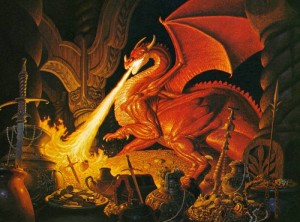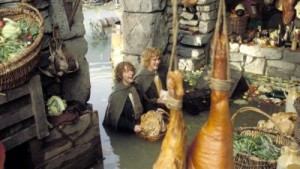
There’s been a heap of uproar recently about how on earth (or Middle-earth) Peter Jackson & Co. will manage to stretch out the plot of The Hobbit to three films. Jackson has made it known that he and his co-writers Fran Walsh and Philippa Boyens (with some Guillermo del Toro tidbits leftover from his earlier collaboration with the Kiwis) are using the appendices from The Lord of the Rings to tell the story of what Gandalf was doing in the four months he was apart from Bilbo and the Dwarves after he left them at “the Gates of Mirkwood.”
This blog is an attempt on my part (and purely speculative) to make an educated guess at the plot of the three films. If you hate spoilers, read no more, because I might just stumble upon a few of those spoilers as I Hobbit-hypothesize, as well as touch upon some of the plot points that have already been mentioned by Peter Jackson and his crew.
First off, I must state that I think three films isn’t enough time to tell The Hobbit, let alone Peter Jackson’s proposed back and forth juxtaposed tale of Bilbo and the Dwarves (with Smaug) on one side and Gandalf and Legolas (battling the Necromancer) on the other. I love long adaptations. In my opinion the greatest adaptation of a novel ever is John Mortimer’s miniseries teleplay for Evelyn Waugh’s Brideshead Revisited starring Jeremy Irons (1981). What makes it so great? The dialogue is almost verbatim from the book and nearly every single scene is kept. The running time of Brideshead is over 12 hours for a book that’s about 350 pages. The Hobbit could easily be given a twelve-hour adaption for its 380 or so pages (depending on your edition) and still keep me riveted.
Back to speculating on the story of The Hobbit Trilogy. Years before the action of The Hobbit begins (over 90 years, in fact) Gandalf had been investigating an ancient fortress called Dol Guldur in the southern part of Mirkwood forest. This evil place was rumored to have been built by Sauron after he’d been defeated during the War of the Last Alliance (i.e. after he got his precious Ring cut off his hand by Isildur), and an entity known only as “the Necromancer” was said to be living there. What Gandalf found in the dungeons of Dol Guldur was a Dwarf who had been tortured for so long he’d gone mad. This was Thorin Oakenshield’s father, Thráin. Thráin gave to Gandalf a map to the Lonely Mountain and a key to the secret door that leads to Smaug’s chamber. (How the crazed Thráin kept the map and key hidden in the dungeons of the Necromancer is anyone’s guess. A body cavity search by an Orc would not be a pleasant experience!)
This set piece alone (Gandalf sneaking into Dol Guldur, finding Thráin, battling his way out against a host of Orcs and perhaps even Ringwraiths while discovering an evil entity who may or may not be Sauron) could take up an entire episode of a miniseries. It will probably only get ten minutes of screen time as either a flashback (Gandalf explaining to Thorin how he came to have his father’s map and key) or quite possibly even the prologue to the first film The Hobbit: An Unexpected Journey.
The first real opportunity in the screen adaptation for Peter Jackson to fit in additional material (that falls within the timeline of the book) is when Bilbo and the Dwarves arrive at Rivendell. In the trailer we get a glimpse of Galadriel speaking to a troubled looking Gandalf, and I can imagine that Gandalf has told her he’s worried that the Necromancer is indeed Sauron and that he’s rebuilt Dol Guldur and is growing an army of Orcs. Perhaps at this point in the film Gandalf, Elrond and Galadriel have a little council where Gandalf tells them they need to enlist his fellow wizard for guidance: none other than Saruman the White.
Gandalf might also tell them he’s been drawn, for some inexplicable reason, to the North–to Mirkwood, Dol Guldur, and the Lonely Mountain–thus giving a solid impetus for the wizard bringing together Thorin & Co. and Bilbo: a motivating force that’s missing from Tolkien’s book. Galadriel most likely would agree with Gandalf about the danger of Dol Guldur. We must remember that she lives in Lothlórien. Her Elven kingdom is only a hundred miles away from Mirkwood and Dol Guldur. The far-seeing Elves could observe, from their high treetop flets, the barren hillside rising from Mirkwood forest upon which Dol Guldur is built. Galadriel would be concerned about what is going on in Mirkwood too, and possibly has already made some sort of connection between Sauron and Smaug the dragon.
This is where the casting of Benedict Cumberbatch as Smaug/the Necromancer comes into play. My guess is that in Peter Jackson’s version of the story the Necromancer (aka Sauron) can possess Smaug the Dragon in the same way Saruman the White possessed King Théoden in the film version of The Two Towers. In Peter Jackson’s version Sauron is using Smaug like a living palantir—a way to view a remote part of Middle-earth that becomes activated by the presence of the Ring. Sort of like a One Ring detector. (The dragons were created by Morgoth, Sauron’s master, to serve as his weapons in the First Age.) In the book Smaug can sense Bilbo’s presence even when he is wearing the Ring and invisible (though the Hobbit reeks of Dwarf and pony which is enough to wake up any dragon). It’s a much more sinister film device, however, if Smaug isn’t merely a big lizard lolling on a heap of gold, but rather a tool of Sauron that has the potential to mesmerize, trap and kill Bilbo and get the Ring back for the Dark Lord. Smaug, in the book, is a clever and fiendish creature. If the voice emanating from his dragon’s mouth is the same as the Necromancer/Sauron, well, this just makes him all the more terrifying.
The next opportunity for the filmmakers to concoct another key scene for Gandalf (using the appendices as a source) comes soon after Bilbo and the Dwarves arrive at Beorn the shapeshifter’s house and Gandalf mysteriously disappears for a spell. Where did he go? Get ready to meet Radagast the Brown, the Istari who has gone native, as played by the great Scottish actor Sylvester McCoy.
To be continued in Hypothetical Hobbit Plotting (Part 2)

